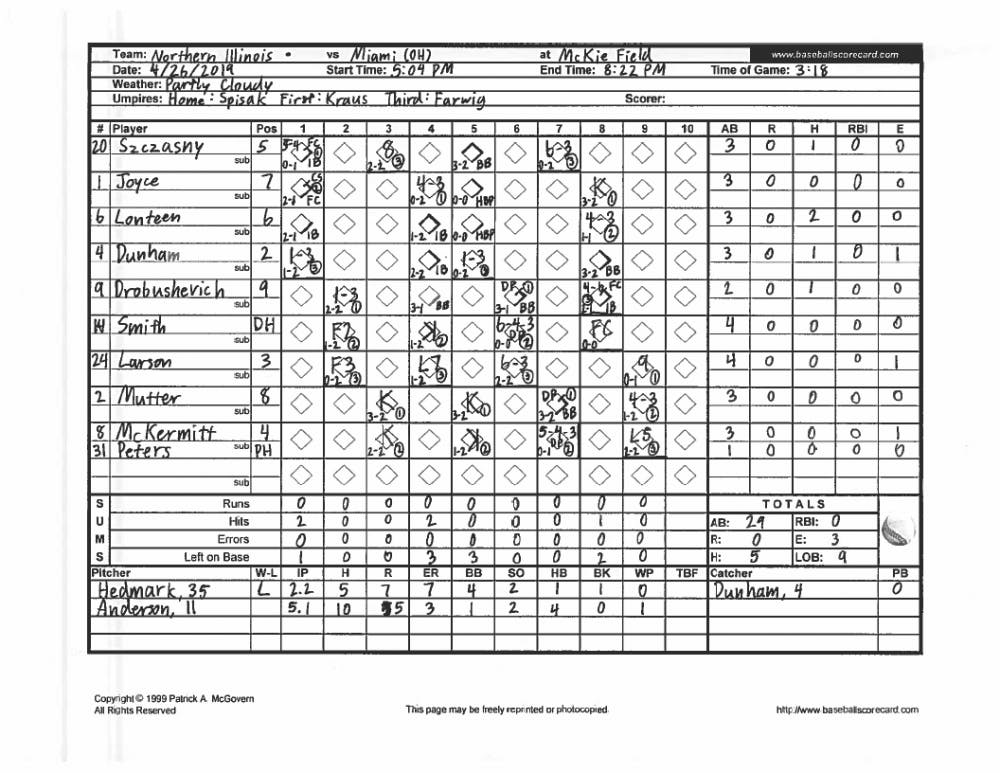Baseball and data go hand in hand. Statistics like batting average, slugging percentage and on base percentage (for batters) as well as earned run average (for pitchers) are inseparable from baseball player profiles. The process of understanding how that data is collected, meanwhile, is a far more complex undertaking.
The Student observed Miami's baseball victory against Northern Illinois (NIU) on April 26 and recorded the scoresheet.
For those who don't appreciate baseball the game appeared boring. And while it may have seemed like a complete blow-out, where not much happened -- Miami beat NIU 12-0 -- the data suggests otherwise.
Baseball scorekeeping is supposed to give the reader a comprehensive summary of the game. There's a lot to unpack, but the beauty of baseball scorekeeping is that all of the data generated during the game is transcribed onto the scoresheet. The scorekeeper must ensure that every minute detail of the game is recorded.
Try to imagine the scoresheet as something similar to an Excel spreadsheet: the batting order is on the vertical axis, the innings are displayed on the horizontal axis and each "cell" represents a batter's plate appearance.
The primary goal of every batter is to use any means necessary to legally touch each base in order, return to home plate and score a run. Part of the reason scorekeeping exists is to show each batter's success, and more broadly, the team's, through how many runs they score.
Scorekeepers are, in effect, documenting the journeys of each batter around the bases. A filled-in diamond indicates a successful trip around the bases, or, a scored run. If a batter fails to score, then the scorekeeper must show how far along the base-path the batter/runner advanced, either before he records an out or the defense records three.
After a quick glance at the scoresheets, Miami was far more successful in scoring runs than NIU during this particular game; twelve runs to zero, in fact.

Data Editor Peter Fortunato
How exactly did Miami score all of those runs? Analyzing the bottom of the first inning when Miami scored two runs will provide us with a sample of the method of scorekeeping.
Leading off, the designated hitter, Christian Tejada, flied out to the center fielder. In scorekeeping, each fielder's position is denoted by a number, as opposed to an abbreviation. This prevents confusion between recording hits (singles, doubles, and triples are written as 1B, 2B, and 3B, respectively) and the infield positions of first base, second base, and third base. And, since Tejada flied out to center field, the number "8" denotes that the center fielder caught the fly ball to record the first out of the inning (denoted by a circled "1").
The second batter, Will Vogelgsang, hit a single. Initially, a line from home plate to first base and "1B" was recorded. The next batter, Landon Stephens, hit a double that allowed Vogelgsang to score. Accordingly, the diamond in Vogelgsang's cell is filled in to show that he scored, and Landon received a run batted in (RBI) during the play. The following batter, Jordan Stephens, hit a single and drove in Landon. Jordan received an RBI and Landon a filled-in diamond.
Enjoy what you're reading?
Signup for our newsletter
The final two batters of the inning failed to advance Jordan. Kyle Winkler flied out to center field, and Cal Elvers struck out looking, which is denoted by a backwards K. Had he struck out swinging, it would have been recorded as a frontward-facing K.
To explain the rest of the game would require a couple thousand more words, so this sample will have to suffice. But the scoresheet helps provide a different perspective to a game enjoyed by millions of Americans. Data might not be unique to baseball, but the sport definitely has unique data.




